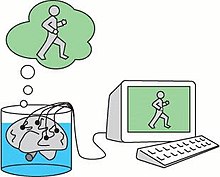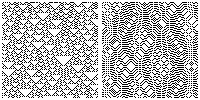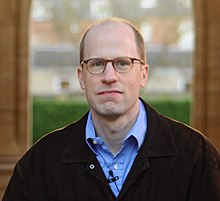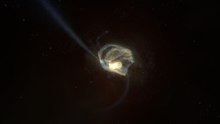Simulation hypothesis
The simulation hypothesis of the philosopher Nick Bostrom is the consequence of an assumption in a thought model . Bostrom calls this thinking model the simulation argument . It consists of three alternatives as to the real or simulated existence of evolved civilizations, at least one of which is said to be true. According to the simulation hypothesis, most people today are simulations , not real people. The simulation hypothesis is to be distinguished from the simulation argument in that it allows this single assumption. It is neither more likely nor less likely than the other two possibilities of the simulation argument.
Assumptions
In his treatise Are you living in a computer simulation (2003), as well as in later, partly somewhat broader interviews, Bostrom uses a thought model in the form of an OR connection ( disjunction ) of the following three basic possibilities of technically “immature” civilizations, such as ours, from. At least one of the mentioned possibilities should be true. As a “mature” civilization or posthuman level , Bostrom describes a civilization that has the computer power and the knowledge to simulate conscious, self-replicating beings with a high level of detail (possibly down to the molecular nanobot level ). Immature civilizations do not have this ability. Bostrom's three options are:
- Human civilization dies out before it has reached a “posthuman” level.
- The percentage of “posthuman” civilizations that are interested in running predecessor simulations is almost zero.
- We are probably living in a computer simulation.
If 1. is true, then it almost certainly follows that human civilizations will not reach a posthuman level at our level of technological development. If 2. applies, then there is a high level of convergence among the technologically advanced civilizations. None of them contain individuals who have an interest in running simulations of their ancestors (predecessor simulations). If 3. is true, then we are almost certainly living in a simulation, and most of us humans are. All three possibilities are similarly likely. If we do not live in a simulation today, then our descendants are more likely not to run previous simulations. In other words, the belief that we may one day reach a “posthuman” level at which we run computer simulations is wrong, unless we are already living in a simulation today.
Structure of the simulation argument

At least one of the three possibilities above is true. Bostrom argues on the additional assumption that the first two possibilities do not occur, that firstly, a not insignificant proportion of our civilization actually achieves technological maturity and, secondly, the interest of a non-negligible part of civilization remains in using the resources to develop previous simulations . If this is the case, in a technologically mature civilization, the scope of the previous simulations reaches astronomical figures. This necessarily takes place on the basis of an extrapolation of the high computer performance and its exponential growth ( Moore's Law ), the possibility that billions of people with their own computers can run predecessor simulations with countless simulated agents and from technological progress with adaptive artificial intelligence , about which one advanced civilization and used at least in part for previous simulations.
According to Bostrom, the consequence of simulating our existence follows necessarily from the assumption that the first two possibilities are not correct. There are many more simulated people similar to us in this case than non-simulated ones. For every historical person there are millions of simulated people. In other words: almost all people with our level of experience live in simulations rather than outside. The conclusion of the simulation hypothesis from the three basic possibilities and from the assumption that the first two possibilities are not true is what Bostrom describes as the structure of the simulation argument.
The simulation argument does not imply the simulation hypothesis that humans are simulations. Rather, the simulation argument shows all three mentioned possibilities side by side, one of which is true. But it remains open which it is. It is also possible, according to Bostrom, that the first assumption occurs, according to which all civilizations and thus mankind will die out for some reason. According to Bostrom, there is no evidence for or against the assumption of the simulation hypothesis that we are simulated beings, nor for the correctness of the other two assumptions.
Bostrom's reflections on his own assumptions
According to Bostrom, we cannot deny that there is a severe limitation that prevents a human civilization like ours from reaching technological maturity. We can also deny, from today's computer industry perspective, that in fact all sufficiently advanced civilizations are losing interest in creating predecessor simulations. However, a more advanced civilization may lose interest in developing predecessor simulations with conscious beings for ethical or other reasons. For these reasons, Bostrom does not attribute an excessive probability to the simulation hypothesis compared to the other two alternatives. From his point of view, it is therefore less than 50%.
Bostrom also draws attention to the side effect that if we are already living in a simulation today and at some point in the future begin to develop and operate previous simulations, simulations of simulations can arise on any number of levels. Such nested simulations can also have arisen before our time, so that the authors of our current simulation do not have to be real beings.
Physical tests of the simulation hypothesis
It is assumed that the simulation of life must contain weak points or small disturbances, since no system is perfect. Slight deviations from natural constants are seen as possible breakdowns . The faster than light speed for measurements of the neutrino speed published in 2011 opened up hope of discovering an insight into such a weak point. However, the finding turned out to be false.
Even if Bostrom does not explicitly add it in his written work, his considerations and discussions with him imply that the simulation hypothesis simulates not only humans, but the entire universe with developments since the Big Bang and the evolution of life can. In 2012, a team headed by the former Bonn physicist Silas R. Beane proposed a method to test whether the simulation hypothesis can be confirmed. In physics it is assumed that the physical space is uniform, i.e. H. is stepless and extends infinitely. However, since computer resources are finite, a simulation has to divide space (universe) into a finite number of discrete grid points . Only in this could the Big Bang, galaxies and atoms be simulated. The continuous physical space allows rays from all directions equally. If one could find evidence of deviations of cosmic rays from the continuity, that would speak for a simulation of the universe.
Results so far indicate such deviations. They found a anisotropy in the distribution of ultra-high-energy cosmic rays . However, these and other indications are currently insufficient to confirm or reject the simulation hypothesis. More data is needed. Bostrom himself thinks it is conceivable that in the future humanity will be able to empirically check whether it lives in a simulation. Furthermore, Campbell et al. in her paper On testing the simulation theory (2017) presented various experiments to test the hypothesis.
Origins of the simulation hypothesis


The origins of the simulation hypothesis can be found in the interpretations of quantum mechanics and the considerations of numerous physicists and computer scientists, including Carl Friedrich von Weizsäcker , John Archibald Wheeler , Stephen Wolfram , Jürgen Schmidhuber and Gerard 't Hooft .
The hypothesis that the universe can be understood as a digital machine came to Konrad Zuse during a stay in Hinterstein in 1945/1946 and was published by him in 1969 in the book Rechnender Raum . In it, he formalized his ideas on “computing space”, based on Stanisław Marcin Ulam's work on cellular automata from around 1940. In Zuse's computing space, all numerical values in the universe are finite and discrete. He pursues the idea of a fundamental digitization of reality, with which he further generalizes the idea of quantizing physical quantities. The core elements of his digital universe are spatially limited structures that are propagated in calculating space. He called them digital particles based on elementary particles. The set of rules according to which digital particles interact is given by the interconnection of the computing space, the original circuit. Konrad Zuse already articulated two core problems of this approach: The computing space is an excellent reference system and not consistent with the theory of relativity . In addition, it does not allow spooky action at a distance .
In his estimation from the 1960s, Carl Friedrich von Weizsäcker arrived at roughly binary information units as part of his quantum theory of the original alternatives . In his essay “The Computational Universe” , Seth Lloyd calculates the computing power and information content of the universe to be approximately to operations or bits since its inception.
Science fiction
In 1999 the topic was processed in the film Matrix , which takes place in a world in which intelligent robots enslave humanity within a simulation.
In 2011 the simulation hypothesis was implemented in the film Source Code , in which the remainder of a human brain is used in the container to prevent a disaster. Here the brain is set back to the starting point of the crime with the help of a "source code", ie a sequential source text, until it can be prevented by it.
reception
Bostrom's model of the simulation argument has been critically discussed on many occasions.
Limited future computer performance
It is noted that it is definitely questionable whether there can be an unlimited exponential increase in computer performance over the long term. Furthermore, there is no evidence that a future, posthuman civilization will be capable of the simulations discussed. That would mean that Bostrom's first assumption (1) is true.
Anthropic principle
The anthropic principle on which Bostrom is based is also discussed . It follows from this that a human observer considers events or alternative events that make his own existence improbable to be improbable or neglects himself. This principle is interpreted by some as philosophical, or viewed as not falsifiable or as unscientific.
Rejection of skepticism
Bostrom's simulation hypothesis is easily discussed in the context of whether or not a real world exists behind a possible simulation ( skepticism ) and, if so, whether it is different from a simulated world (e.g. Plato's theory of ideas ). For Bostrom, however, this question is not his topic. The simulation hypothesis is part of the simulation argument, which contains three alternative possibilities that we can ask for empirical reasons. The simulation argument is based on real experience. A skepticism of the real world, as with Descartes and his brain in the tank, is therefore not appropriate for the simulation argument according to Bostrom. Rather, Bostrom wants to explore more knowledge through a special OR link ( disjunction ). The simulation argument wants to tell us something about the world. Nevertheless, the specific question is just as permissible in the context of the simulation hypothesis, i.e. H. the question of what reality is hidden behind a possible simulation, under the special assumptions of the simulation argument that we live in one. Bostrom says that if we live in a simulation, there has to be an underlying reality that allows that simulation. The Australian philosopher David Chalmers also comes to the conclusion that the matrix hypothesis, as he describes the simulation hypothesis without direct reference to Bostrom, is not a skeptical hypothesis. “If that's true, I shouldn't conclude that the external world doesn't exist, that we don't have a body, that there aren't any tables, chairs, or bodies, or that I'm not in Tucson. Rather, I should conclude that the physical world is based on calculations beyond the microphysical level. Tables, chairs and bodies still exist: these are basically made of bits and whatever constitutes these bits. "
Simulated awareness
One of the greatest challenges of the simulation hypothesis is the creation of artificial consciousness in computers in the form of a continuous stream, a property that David Chalmers formulates as essential for personal identity. Today science does not even know how consciousness arises in the brain ( body-mind problem ). Against this background, whether it is basically possible to generate machine consciousness and whether this is comparable to our consciousness is controversial, between more skepticism and more consent.
Elon Musk's theory
A popular proponent of simulation theory is Elon Musk . Musk's views imply the work of Bostrom. He emphasizes the enormous advances made by video games since their inception, from the simple pong with two rectangles and a point that is moved back and forth to the photo-realistic animation games that were played online by millions of players simultaneously only 40 years later . These are getting better from year to year and have an enormous potential of virtual reality to simulate human life and nature indistinguishably from real life. In the long term, this applies even if technical progress were reduced by a factor of 1000, for example. According to Musks, such a development process may have already taken place in the past and lead to the fact that we are now living in a simulation. Unlike Bostrom, Musk believes that there is only a one-in-several-billion chance that we won't live in a simulation. He believes there are billions of simulated universes indistinguishable from ours. We are in one of them. Musk comes to the conclusion: "If civilizations stop advancing, it can be due to a catastrophic event that wipes out a civilization." Hence his conclusion: "Either we create simulations that are indistinguishable from reality, or we become civilizations cease to exist. "
See also
literature
- Nick Bostrom : Are We Living in a Computer Simulation? In: The Philosophical Quarterly. 53, 2003, p. 243, doi: 10.1111 / 1467-9213.00309 .
Web links
- Are you living in a computer simulation? The simulation argument . (This website is mentioned in Bostrom's 2003 paper.)
- Nick Bostrom: The Simulation Argument. (Full) (YouTube)
- Do We Live in a Simulation? | Nick Bostrom Interview (YouTube)
- Elon Musk Simulation Theory Interview. (YouTube)
- Why Elon Musk says we're living in a simulation. (YouTube)
- Felt Reality Does Humanity Live in the Matrix? In: Spiegel Online. November 16, 2004.
- We might live in a computer program but it may not matter. In: BBC Earth. 5th September 2016.
Individual evidence
- ↑ a b c Nick Bostrom: Are you living in a computer simulation? In: Philosophical Quarterly. Vol. 53, no. 211, 2003, pp. 243-255. (on-line)
- ↑ a b c d e The Simulation Argument FAQ .
- ^ Barry Dainton: On singularities and simulations. In: Journal of Consciousness Studies. Volume 19, No. 1, 2012, p. 60. (online)
- ↑ a b c d e Nick Bostrom: The Simulation Argument. (Full) (YouTube)
- ↑ a b c Zeeya Merali: Do We Live in the Matrix? Physicists have proposed tests to reveal whether we are part of a giant computer simulation. In: Discover. December 2013, pp. 24-25. (on-line)
- ↑ This is how we find out if we live in a matrix. on: welt.de , October 16, 2016.
- ↑ Now officially: neutrinos no faster than light. on: welt.de , December 8, 2012.
- ↑ Are We Living in a Simulation? (YouTube)
- ↑ Life in the Matrix. In: FAZ. December 25, 2012.
- ↑ Silas R. Beane, Zohreh Davoudi, Martin J. Savage: Constraints on the Universe as a Numerical Simulation . 2012, arxiv : 1210.1847v2 [hep-ph] .
- ↑ Tom Campbell, Houman Owhadi, Joe Sauvageau, David Watkinson: On testing the simulation theory. 2017 arxiv : 1703.00058v2 [quant-ph] .
- ↑ Konrad Zuse: Computing Space , Spectrum of Science, reprint in the March 2007 edition: "Is the universe a computer?".
- ↑ Konrad Zuse : Computing room . In: Electronic data processing . tape 8 , 1967, p. 336–344 ( original scan [PDF] a classification ).
- ↑ Konrad Zuse: Computing Room (= writings for data processing . Volume 1 ). Vieweg, Braunschweig 1969, ISBN 3-528-09609-8 .
- ^ Brian Whitworth: The Physical World as a Virtual Reality. 2008, arxiv : 0801.0337v2 [cs.OH] .
- ^ Seth Lloyd : The universe as quantum computer . In: A Computable Universe: Understanding and exploring Nature as computation. 2013 arxiv : 1312.4455v1 [quant-ph] .
- ↑ Konrad Zuse: The computer - my life's work . 3. Edition. Springer, Berlin 1993, ISBN 3-540-56292-3 . P. 93.
- ^ Seth Lloyd: Computational Capacity of the Universe. In: Physical Review Letters. 88, 2002, doi: 10.1103 / PhysRevLett.88.237901 . arxiv : quant-ph / 0110141v1 .
- ^ Lloyd, S .: The Computational Universe: Quantum gravity from quantum computation. arxiv : quant-ph / 0501135v5 .
- ^ Brian Weatherson: Are you a sim? In: The Philosophical Quarterly. Volume 53, No. 212, 2003, pp. 425-431. ( online )
- ^ Barry Dainton: On singularities and simulations. In: Journal of Consciousness Studies. Volume 19, No. 1, 2012, p. 42. (online)
- ^ Paul Davies, Charles William: Multiverse cosmological models. In: Modern Physics Letters A. Volume 19, No. 10, 2004, pp. 727-743.
- ↑ Nick Bostrom. Anthopic bias. Routledge 2010. ISBN 978-0-415-88394-8 . (on-line)
- ↑ a b Chalmers, David. J. The Matrix as Metaphysics, in Grau, C. (ed.) Philosophiert explore the Matrix. Oxford. Oxford University Press ( PDF ).
- ^ DJ Chalmers: The Singularity. A philosophical analysis. In: Journal of Consciousness Studies. Volume 17, No. 9-10, 2010. pp. 7-65. ( Online )
- ↑ Steve Ayan (Ed.): Riddle Man. Expeditions in the border area between philosophy and brain research . Springer, 2017, ISBN 978-3-662-50326-3 .
- ^ Barry Dainton: On singularities and simulations. In: Journal of Consciousness Studies. Volume 19, No. 1, 2012, p. 46 ( PDF ).
- ↑ Elon Musk Simulation Theory Interview (YouTube)
- ↑ Why Elon Musk says we're living in a simulation. (YouTube)






